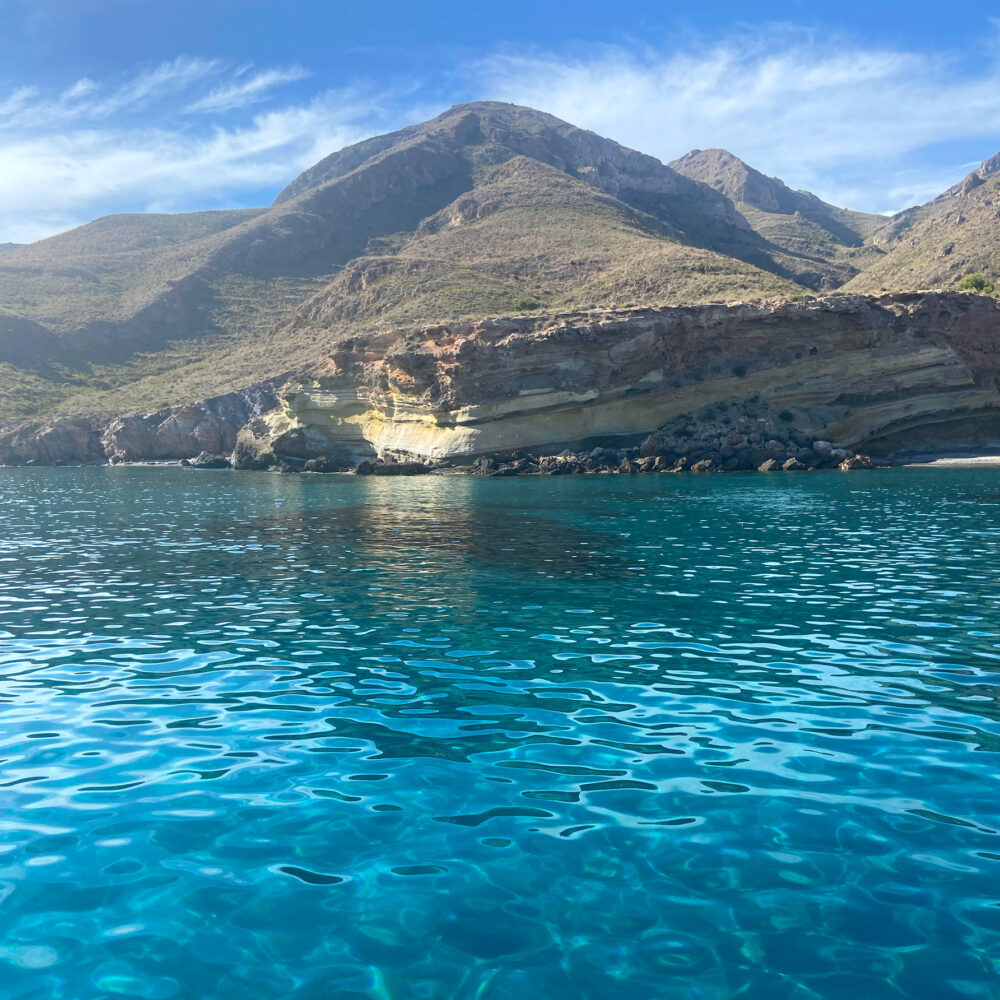
11 Dec Five tips for successful and happy anchoring
We LOVE to be on anchor! I mean, staying in a nice marina can be really comfortable – easy peasy shopping, laundry facilities nearby and hot running water in amounts that you would never consider when not in a marina – what’s not to like?
Well, the cost is one thing – our budget does not allow us to stay in marinas a lot, even if we wanted to – but the main thing missing in a marina is the outlook! The horizon, the calm, and the feeling of freedom. Being self-sustained – and self-dependant – and able to jump in the water first thing in the morning. That’s unbeatable.
So we’ve done a lot of anchoring. Before setting sails south, we did short trips to small anchorages close to where we lived, and summers were spent anchoring in the southern parts of Denmark or in Sweden, both areas filled with small islands, inlets and coves that lets you breathe in and breathe out in the pace that suits you.

On our way along the Atlantic coastline of Europe, conditions for anchoring became a little more difficult, but we opted to anchor out, whenever it was possible. This means that we’ve anchored at the Dutch estuaries of the Schelde river, at the Channel Islands Sark and Guernsey, in the river Douro by Porto, in beautiful cliff coves along the Algarve coast of southern Portugal, in the river Guardiana marking the border between Portugal and Spain, and – once in the Med – at terribly rolly bays along the Costa del Sol and in some breathtakingly picturesque calas along the Costa Calida, en route to Cartagena, where we went into the marina for the winter.
So I find myself fit to pass on a few of our best tips for happy anchoring. I’m of course still a Rookie, so I might update this post with more experience at a later point. But here goes – these are our tips and tricks for a successful anchoring experience:
#1
Find a good location
In my opinion, this is key to a happy anchoring. To pick a good location is not always easy and involves a range of parameters:
– Wind direction and wind strength – if only light winds are expected, you don’t need as much shelter. If you are anything like us though, you always want as much shelter as possible for a good night’s sleep.
– Swell direction – important if swell and wind direction are not the same, or if the wind dies. Swell from the side means one rolly night and you might need to spring the line or set a stern anchor.
– Type of bottom – sand is preferable, mud is all right (with our anchor) weed will do (if it’s not protected), clay can be ok, rock is to be avoided.
You can use Navily to get information and recommendations from other sailors; these can be very valuable but as every community based service, it has its biases. Use your charts for locating depths, obstructions and even bottom types. Google maps can also be used to identify where the sand bottom is – probably next to the beach, and not the neighbouring cliffs. Windy or PredictWind can give you wind forecasts as well as swell predictions
#2
Approach with caution
Even when you’ve planned well, identified depths, obstructions and bottom types, once you reach the location, I advice you to slow down and use your senses to gather more information. Consider the following:
– Are there other boats in the anchorage?
– Is there any unexpected swell or current that you need to take into consideration?
– Do the depths match your charts?
– Are there any other hazardous objects to look out for (fishing nets, crab pots, crazy jetskiers etc.)?
#3
Use hand signals
So you’ve found your location and decided where you want to drop your anchor. If you’re double-handed and one of you needs to go to the bow to drop it, agree on some simple hand signals that you can use to communicate. Why?
– Because no one wants to be the shouting boat couple that disturb the calm of the anchorage.
– Because not being shouted at keeps all crew happy.
– If the wind is howling, you won’t be able to hear anything anyway – which then causes a risk.
#4
Lay out a good scope of chain
This one is a debated topic, and can also be dependent on a range of different factors that might even give opposing conclusions. As a rule of thumb, you’ll want at least 1:4 the depth when the weather is calm. 1:5 / 1:6 or more in stronger winds. We tend to put out more chain as the weather turns gnarlier if (!) there is enough room in the anchorage. A few things can challenge the rule of thumb:
– The approximity to other boats. If you anchor at 10 m in some winds, 50 m of chain could be right. But if your neighbour boat is only 15 m away, you’ll need to consider your boat types compared to expected swinging patterns, currents that might shift during the night, and if you feel comfortable with his or her anchoring capabilities.
– The surroundings and the surrounding depths. If you expect a shift in wind direction, make sure that you have enough swinging room with your length of chain out.
#5
Set the anchor well
Presuming that you have a good anchor that fits your boat size (we have a Mantus 29,5 kg for our 42 feet / 10 tons boat), I recommend that you follow these steps:
– Point the bow into the wind.
– Wait until the boat is no longer in forward movement.
– Let out enough chain for the anchor to hit the bottom + a few extra meters.
– Set the boat in reverse gear, just so that the chain stretches out.
– Let out the rest of your planned measure, while the boat slowly stretches out the chain. It is very useful to have marked your chain with colours for every 10 meters.
– When you feel that the anchor holds, the boat corrects itself with bow to the wind, and you’ve stopped moving backwards, put the engine in reverse and slowly turn up the revs. We test up to 1700 revs, to make sure that the anchor holds, even with some strain on it.
– Once you’re happy with your anchoring, set a snubber and let out a little more chain, to release tension on the anchor windlass.
Notes:
! Some argue that you should put a trip line in your anchor, in the case that the anchor gets stuck, once you want to leave the anchorage. We haven’t had this issue or used a trip line so far, so I cannot advise on this.
! Some set two snubbers, in the case that one slips.
! Some set a stern anchor to prevent the boat from swinging, or to keep it from rolling too much, should the swell and wind directions not be optimal. We have only tried the stern anchor once, with some success. It is however a bit of a hassle to set, but can be worth it in a rolly anchorage. Remember to consider other boats and their swinging patterns, if you set it.
! In some anchorages, where a lot of boats are anchored, you’ll have to anchor close to shore, and it might be worth it to take a line to shore to keep the boat from swinging and thereby reduce your needed space. We have only done this a few times, but I’d recommend that you coil up the line neatly on the boat, and take it in in the dinghy, slowly taking out more line. Tie it to a branch or rock, and as always remember to consider how you get to shore from the dinghy.
Would love to hear your experiences. Let us know in the comments, also if you find that something is missing.

Jørgen Gullev
Posted at 13:11h, 12 DecemberHej med Jer
Rigtig Godt indlæg
En bemærkning til kommunikation når der står en i spidsen .. hvis begge har en telefon og et headset virker det perfekt at bruge det . Du kan arbejde og være opmærksom samtidig med du taler
Jeg sejler sydpå fra Dk start maj og vil høre om i har gode ankerpladser inde i Biscayen ( Frankrig og Nordspanien. )
Fortsat god tur og vind
Hilsner Jørgen
admin
Posted at 16:04h, 12 DecemberHej Jørgen,
Tak for kommentaren og rosen, det sætter vi pris på.
Super god idé med mobilen og headset – hvis ikke vinden brager derudaf. Vi har set flere med deciderede radio-headsets og synes måske det er lige i overkanten, så er din idé da noget mere budgetvenlig.
Vi sejlede over Biscayen fra Audierne til Viveiro, så vi så desværre ikke så meget af den indre del af Biscayen. Men ankerpladsen ved Camaret-sur-Mer var god – bedre end marinaen – og ankerpladsen ved Audierne/Anse de Sainte-Evette var super hyggelig. Da vi ankom blev vi mødt af en ung kvinde i en dinghy, hun tog simpelthen ordrer på morgenbrød, der så blev leveret morgenen efter, klasse! 🙂
På den anden side var Viveiro efter vores vurdering, den mest beskyttede af de tre første rias på norsiden af Galicien. Og super flot forøvrigt.
Sæt så meget tid af som muligt fra A Coruña og ned, de fire rias efter Cap Finisterre er magiske.
Spændende I også drager sydpå, hvad sejler I afsted i?
Laila Schønhardt
Posted at 18:18h, 12 DecemberHello!
Nice blog! We are a couple from Norway sailing a Beneteau Oceanis 473, so much the same. Yesterday we anchored in a bay with lines to shore (two) and that was perfect. It was quiet and we had almost no wind, and it was only one another boat with no people onboard. We talked to another sailor today, he was anchoring in the bay next to us, and he said there was too many boats and wind up to 50 knots… We were in that bay yesterday but we saw that the wind would change so we decided to go to another bay. So it is importent to choose the right bay. We are in Marmaris, Türkiye, at the moment and if the wind is from the south it will be a lot of swell from south, but the bay is huge so you will find a better place to stay if needed. We have been here for two weeks but mostly very quiet and no swell Where are you? We will sail back to Greece in the end of february I think. Norway is not in the EU so we can`t stay more than 3 months in EU… Check us out on sailingfelizia.com 🙂
perry
Posted at 03:40h, 14 DecemberMate, dont go telling people how good it is outside of the marinas. We WANT them to stay there!!!!
admin
Posted at 13:30h, 18 DecemberHahaaaa… Sorry!!
Let’s hope there is space for all of us out there. 🙂